As Professor Faull has repeatedly said, corpus construction can be the most difficult part of textual analysis. After a few weeks into my research, I have found that she could not be more correct. First there is the task of collecting works for the corpus, which can involve internet searches leading to parts of the internet unbeknownst to me. Canadian archives where copyright laws have made most of what I was looking for available, became my saving grace, and offered me a great set of texts, that lend themselves perfectly to my research question.
The problem from that point was the cleaning. The only unfortunate part about the Canadian texts, were that they came in the form of PDF, a file incompatible with most textual analysis engines. For this reason, I have had to begin the most laborious part of my project, the cleaning and parsing of thousands of pages of literature. This involves moving all the text over to text editor, and then proceeding to go through and delete all the commentary that was not from either Tolkien or Lewis. This has proved rather bothersome, as some of the version of the texts I found seemed to have editors that were quite loquacious in their added script. All this must go, along with dates and other things, and be transferred into a meta data sheet. For examples sake, the following pictures are samples of the Chronicles of Narnia, before and after cleaning.
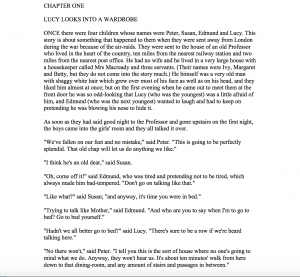
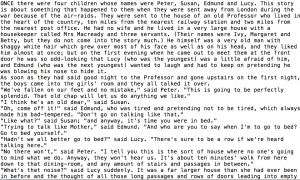
To the left, the text looks like one might find in the actual novel, but to the right, the pure texts has been edited into a form ready to be read by engines such as Voyant and AntConc.
This provides a smooth transition into the far more interesting part of our research; the actual research.
The nature of my research question in inherently differential, as I am comparing two distinct authors.
My general is question: How do Tolkien and Lewis differ in the ways their writing reflects their spirituality? Does this mean that they have different views on religion or do they simply express it in different ways?
Accordingly I preformed searches in Voyant and AntConc in the main works from both authors. We began with Voyant and therefor it was the first engine I used. I wanted to look and see the usage of main characters and certain adjectives in both texts over time. These were my results
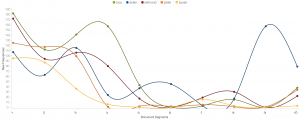


On the left, we have the Lord of the Rings and on the right, The Chronicles of Narnia. I performed frequency searches for the main characters on top, and then on the bottom, I search for the most common collocates of the words “dark” and “evil”. This was using Voyant.
Next, we moved onto AntConc. I used the Concordance tool to look at similar searches, looking for the hero and villain terms from each work.
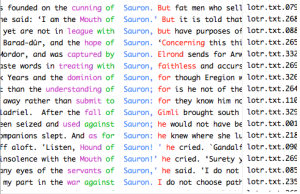
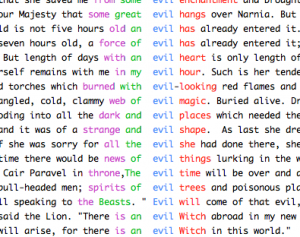
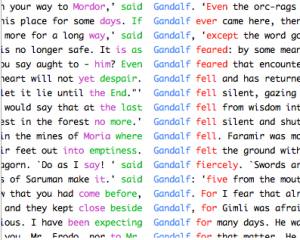
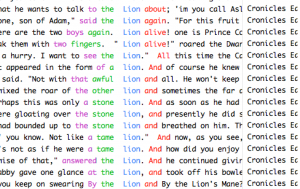
Again, on the left, was the LOTR search and The Chronicles on the right. Using the concordance tool, I found was able to see a complete list of the words surrounding the key terms for my research. This was a powerful tool for me.
Comparing the two platforms
Frankly for my research, AntConc has proven to be invaluable and far superior to Voyant. The ability to find concordances, as well as a more detailed collocates list trumps the less detailed information that Voyant gives. The most valuable tool AntConc offers, for me, is the Keyness search. Using this I have been able to compare the frequency of key religious terms in regards to the respective texts. This has been vital.
Using these tools I have discovered some interesting pragmatics of the Tolkien and Lewis texts. For example by searching for concordances of the respective “higher powers” in each text, I have found that Lewis tends to humble his savior character, while Tolkien empowers his villains, both creating the same effect.
Lewis describes Aslan, the lion, and a clear metaphor for a holy figure, as “humble” and “tame”, in a similar way that the bible describes Jesus. Conversely, Tolkien describes Sauron, the main villain and demigod of LOTR, as “powerful” and “fearsome”. While both craft their religious heroism in different ways, they provide the same effect. The less powerful hero (The lion or The Hobbits) defeat the seemingly omnipotent villain (The witch or Sauron).
The next step in the process will include looking into the authors other works, as well as reflecting further upon these findings to discover more upon the religious reflections of the works.